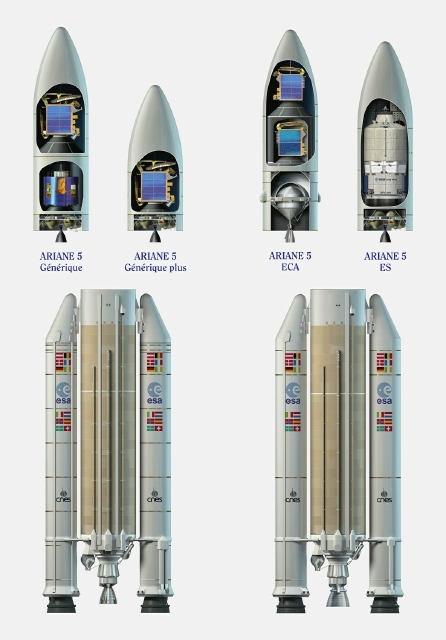Programme overview
Ariane 5 launch log up to its 109th flight in August 2020. Credits: ESA.
Detailed objectives
Ariane 5’s twofold aim was to continue sustaining Europe’s independent space launch capability and to stay competitive in the commercial market. To this end, it was a heavy-lift launcher capable of orbiting two satellites weighing nearly 5 tonnes each at the same time. Its ES variant was also capable of launching the ATV cargo resupply spacecraft to the International Space Station (ISS) or four Galileo navigation satellites. This multiple-launch capability made it one of the most competitive vehicles in the world, and its track record one of the most reliable. Up to September 2018, Ariane 5 experienced since 1996 only two complete failures on test flights and two partial failures in 117 launches —all variants included.
From 2020, only a single variant was commercially operated: compared to Ariane 4’s lift capacity of 4.9 tonnes into geostationary transfer orbit (GTO), Ariane 5 ECA could carry twice the payload, with 10 tonnes into GTO for a dual launch and 10.8 tonnes for a single launch.
Ariane 5 thus offered the versatility to loft all kinds of payload into different Earth orbits, from small satellites weighing less than 1 tonne to heavy payloads of up to 20 tonnes, as well as 6 tonnes to the Earth-Moon and Earth-Sun Lagrange points (as it did for the Herschel and Planck telescopes).
From 2024, the new version of Ariane will be Ariane 6. Ariane 62 will cater to intermediate launches while Ariane 64 will be for heavy-lift missions. This modularity will ensure even more competitive launch services for Europe, with production costs 40% lower than for Ariane 5, and the launch rate will increase from 6-7 launches to 11 launches a year.
Programme history

Ariane 5 was designed to evolve in line with new market needs and technical innovations. Two distinct evolution programmes—Ariane 5 Evolution, initiated in 1995, and Ariane 5 Plus in 1998—thus gave rise to new variants of the launcher, bringing performance gains for launches into geostationary transfer orbit.
Ariane 5 Evolution sought to enhance the performance of the lower composite (with Vulcain 2, a more powerful engine for Ariane 5 ECA’s cryogenic stage, and a lighter structure for the two solid boosters). Ariane 5 Plus focused on the power and versatility of the upper stage (HM-7B engine for Ariane 5 ECA).
- G (Generic): the generic variant of Ariane 5, operated commercially for 13 launches between 1996 and 2003.
- ECA: operated commercially between 2002 and 2023, both stages of this variant offered performance gains over Ariane 5 G. With 84 launches to its credit up to December 2023, Ariane 5 ECA was the only variant operated commercially since the retirement from service of Ariane 4 in 2003 and of Ariane 5 ES in July 2018.
- G+: alongside the ECA variant, this was an enhanced and more reliable G variant conceived after the failure of flight V517, the maiden launch of ECA. Operated commercially for three successful launches in 2004.
- GS: enhanced version of the G+ variant incorporating evolutions to ECA. Operated commercially for six launches between 2005 and 2009.
- ES (Evolution Storable): strengthened variant built in 2008 to launch ATV cargo resupply spacecraft to the ISS. After the ATV was retired from service in 2014, Ariane 5 ES was then operated up to July 2018 to accelerate deployment of the Galileo constellation in groups of four satellites.
- ME (Midlife Evolution): variant initially planned for 2017-2018 but cancelled and replaced by Ariane. It would have provided a big performance boost, from 10 tonnes to 12 tonnes into GTO. In place of the HM-7B, the new upper stage was to use the more powerful reignitable Vinci engine, which will be operating on Ariane 6.




